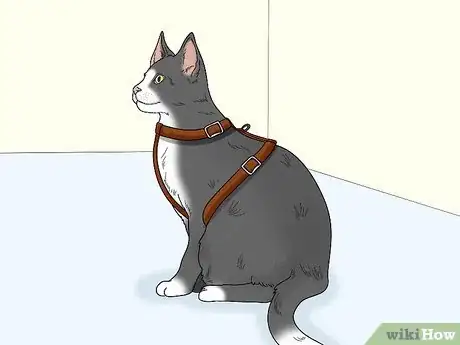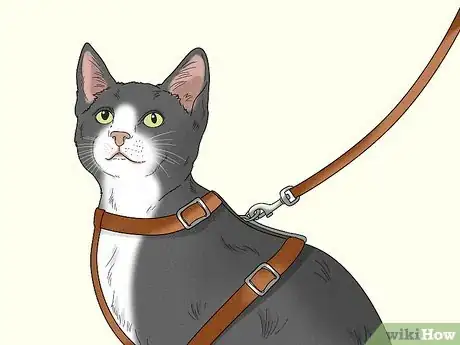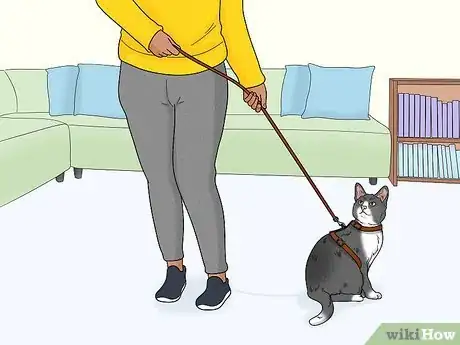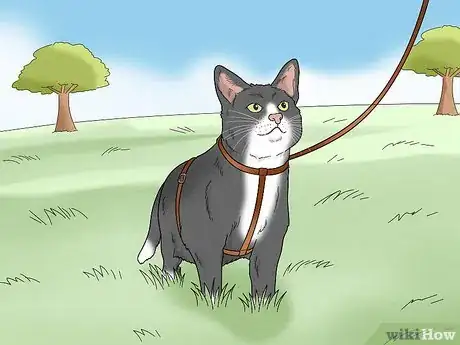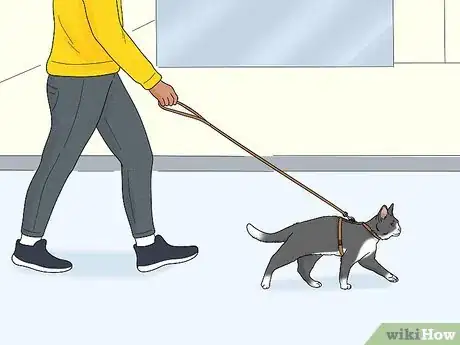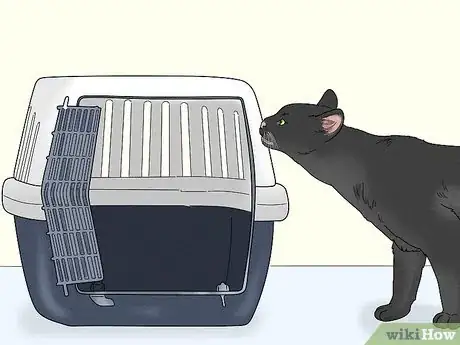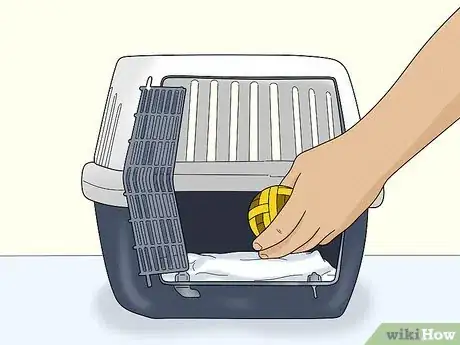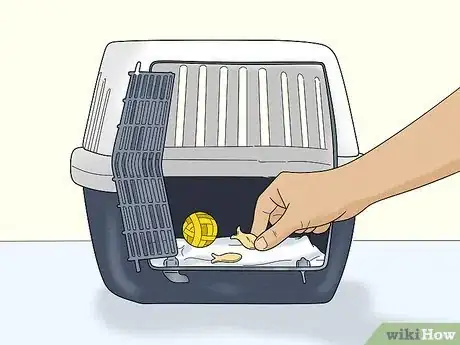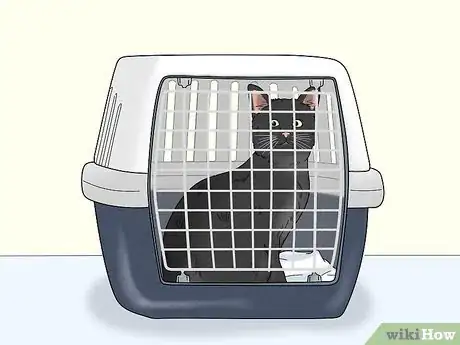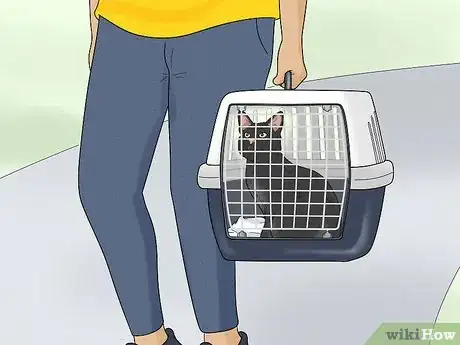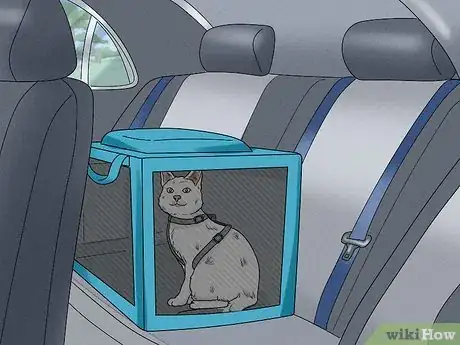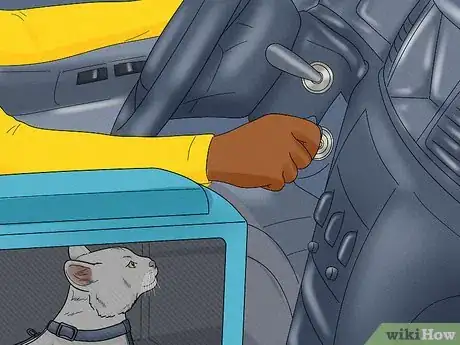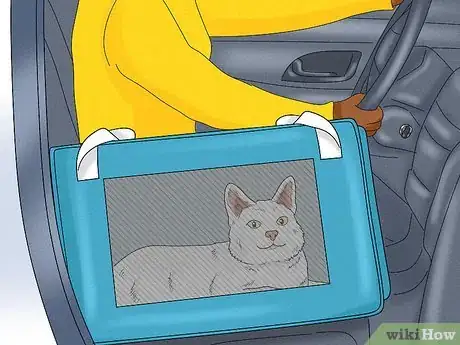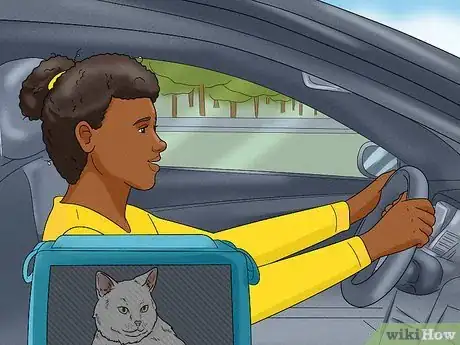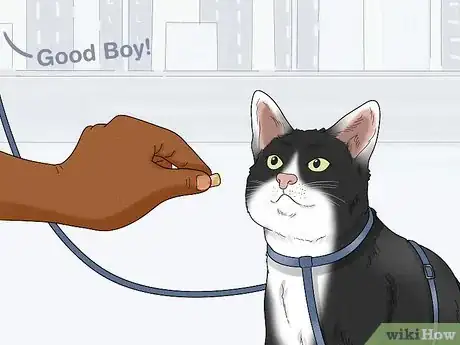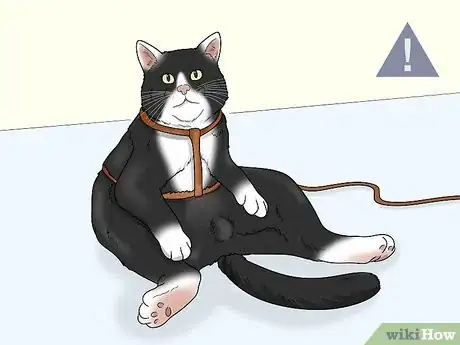This article was co-authored by Pippa Elliott, MRCVS. Dr. Elliott, BVMS, MRCVS is a veterinarian with over 30 years of experience in veterinary surgery and companion animal practice. She graduated from the University of Glasgow in 1987 with a degree in veterinary medicine and surgery. She has worked at the same animal clinic in her hometown for over 20 years.
wikiHow marks an article as reader-approved once it receives enough positive feedback. In this case, several readers have written to tell us that this article was helpful to them, earning it our reader-approved status.
This article has been viewed 95,057 times.
Contrary to some beliefs, it is possible to train a cat to ride stress-free in your car. You can even teach your kitty to 'do its business' at rest stops along the way. All it takes to travel train your furry friend is a little patience and a lot of love. Get your cat used to the travel process step by step. Start with leash and halter training, then train your cat to sit calmly in a cat carrier. When your cat is ready, help it get comfortable being in the car.
Steps
Getting Your Cat Used to a Halter and Leash
-
1Get a halter that is specifically designed for cats. Cat halters or harnesses are available at most pet supply stores. Get one that is adjustable and made for your cat’s size and weight range. It should fit snugly, but not painfully tight.
-
2Let your cat get used to wearing the halter. Allow your cat to sniff the halter thoroughly, then place it on the cat. Let the cat wear it until it forgets that the harness is there. Do this daily for a week. Reward your cat with treats and praise each time you put on the halter.Advertisement
-
3Snap a lightweight leash onto the halter. Supervise your cat while the leash is attached—it could get caught on something. Let the cat drag the leash around the house until it forgets the leash is there. Do this daily for at least 2-3 days. Again, reward your cat with treats and praise each time.
-
4Take hold of the leash. If your cat shows no reaction, tug the leash gently and call the cat. Do this a few times a day, for 5-10 minutes at a time, for a week. Reward with treats and praise each time it responds to your call or a gentle tug.
-
5Take your cat outside on the leash. Once your cat is used to walking with you on the leash indoors, try letting your cat outside to explore. Stick to your yard at first, until the cat becomes comfortable with being outside on the leash.
-
6Start taking your cat for short walks. Try taking brief walks around the neighborhood with your cat. Let the cat wander and explore, but gently redirect it if it tries to go into the street or go after birds. If your cat goes to the bathroom outside, offer praise and treats.
Getting Your Cat Accustomed to a Carrier
-
1Keep your carrier where the cat can get at it. Cats learn to dislike carriers when they associate them with strange and frightening events, like trips to the vet. Instead of storing the carrier away and only breaking it out when it’s time to travel, keep it somewhere accessible where the cat will see (and smell) it regularly. Leave the door open so the cat can go in and out of it at will.[1]
-
2Make the carrier comfortable. Put an old towel or blanket inside the carrier, and toss in a few of your cat’s favorite toys. Get your cat used to the idea that the carrier is a cozy and inviting place.[2]
-
3Offer treats and food inside the carrier. Call your cat and offer a special food treat or some catnip inside the carrier. Do this regularly, so that the cat gets used to going into the carrier when you call and offer a treat.[3]
- Try saying something like “Treat!” or “Here, kitty, kitty!” whenever you offer the cat a treat inside the carrier. Your cat will soon learn to come and enter the carrier when you call.
-
4Try closing the door when your cat is inside. Once your cat is used to spending time in the carrier, try closing the door from time to time. Offer a treat first, then close and lock the door while the cat is eating. If your cat gets upset, open the door and try again later. If your cat stays calm, offer another treat and praise the cat.[4]
- Gradually increase the time that the door stays shut with the cat inside.
-
5Try picking up the carrier. After your cat gets used to being inside the carrier with the door shut, practice gently picking the carrier up with the cat inside. If your cat remains calm, praise it and offer more treats. Incorporate this into your regular routine.[5]
-
6Walk around with the cat in the carrier. If your cat is able to stay calm when you pick up the carrier, start moving around. Don’t go far at first—just pace around a little with the cat in the carrier. After doing this a few times, try taking the carrier outside and going for a short walk.[6]
- Stop if your cat gets upset, and try again later. Try a shorter walk next time, and gradually increase the length of your walks until the cat gets used to it.
Training Your Cat for Car Travel
-
1Place your cat in the car without turning on the engine. Put your cat on a leash and harness. Get in the car with your cat and allow it to explore the car thoroughly. Remember not to turn on the engine. Do this for at least two consecutive days — longer if the cat is uncomfortable.
-
2Place your cat in the car and turn on the engine. Let the cat get used to the sound and feel of the engine running. Repeat this step daily until the cat is fine with it. Praise your cat and offer treats if it remains calm.
-
3Place your cat in a carrier in the car while the engine is running. Repeat this step daily until your cat is fine with it. If your cat is carrier trained, this might not take any time at all. Be sure there's a towel or cloth in the carrier so the has something to grab a hold of with its claws. This will reassure the cat.
-
4Take your cat on short trips around the block. Limit your trips to approximately 5 minutes or so. Don't do this more than twice a day. The first time or two, your cat might be scared and vocal — most cats dislike the vibration of a moving vehicle. Try to stick to smooth roads in the beginning. Repeat this step until the cat is quiet and not afraid to be in the moving car. This is the most important step! Give your cat lots of praise and treats after the ride, so that it looks forward to the next trip.
-
5Expand your daily trips. Do this until the cat is accustomed to being in the car for long periods of time. Take your cat to a park, put it on a leash and halter, and let it out of the car to sniff around and drink some water. If your cat goes to the bathroom at the park, reward it profusely. Repeat this step for a while and your cat will love going for rides with you!
Using Good Training Techniques
-
1Start when your cat is young, if you can. Kittens and young cats are better at adjusting to change. Adult cats tend to become set in their ways and are more easily upset and stressed by changes in their routine. Start getting your cat used to travel as early as possible.[7]
-
2Use positive reinforcement to train your cat. Cats don’t respond well to punishment and scolding.[8] If you want to train your cat to travel in a carrier or walk on a leash without stress, do your best to create positive associations with these activities. Praise your cat and offer treats to reinforce good behavior.
- Don’t scold or punish your cat for failing to do the “right” thing. This will only cause the cat to feel upset or fearful, and will be counterproductive to the training.
-
3Break each task down into manageable parts. Don’t expect your cat to learn everything at once. Training your cat will take time. Wait until your cat has one part of the process mastered (e.g., feeling comfortable in a harness) before moving on to the next part (e.g., walking in the harness with a leash attached).
-
4Make sure your cat is hungry before each training session. Getting treats is a big incentive for a cat. If you can’t reward your cat with treats because it’s too full to eat, the training session won’t be particularly productive. Wait for a time when your cat is feeling alert and at least a little hungry.[9]
-
5Stop before your cat starts to get distressed. If your cat is feeling frightened, tired, or irritable, you’re not going to get much out of the training session. If you consistently end your training sessions on a bad note, the cat will also begin to develop negative associations with travel or leash training. If you can, end each session while things are going well and your cat is in a good mood.
Expert Q&A
-
QuestionAt what age can a cat travel?
 Pippa Elliott, MRCVSDr. Elliott, BVMS, MRCVS is a veterinarian with over 30 years of experience in veterinary surgery and companion animal practice. She graduated from the University of Glasgow in 1987 with a degree in veterinary medicine and surgery. She has worked at the same animal clinic in her hometown for over 20 years.
Pippa Elliott, MRCVSDr. Elliott, BVMS, MRCVS is a veterinarian with over 30 years of experience in veterinary surgery and companion animal practice. She graduated from the University of Glasgow in 1987 with a degree in veterinary medicine and surgery. She has worked at the same animal clinic in her hometown for over 20 years.
Veterinarian The younger the better! A kitten less than 12 weeks old is within her socialization period and will quickly learn to accept a carrier and car travel. Any age cat can be taught to travel without stress, but how long it takes to achieve this will depend on the cat's previous experiences and how willing they are to learn.
The younger the better! A kitten less than 12 weeks old is within her socialization period and will quickly learn to accept a carrier and car travel. Any age cat can be taught to travel without stress, but how long it takes to achieve this will depend on the cat's previous experiences and how willing they are to learn.
Warnings
- Some cats get carsick. Don't feed your cat or give him treats until the ride is over. Water is fine. If you're taking a long trip, try not to feed him during the trip (he won't starve in a day), or feed him at the beginning of a nice long stop, perhaps when stopping for a meal yourself.⧼thumbs_response⧽
- A frightened cat can pull out of a cat harness by wrenching his head out of the opening. Never tug the harness forward when walking in front of the cat, or he'll slip out of it easily.⧼thumbs_response⧽
- Strap the cat carrier in place with the seat belt. If you stop suddenly and it slides off the seat, your cat will be terrified and may regain his fear of cars.⧼thumbs_response⧽
References
- ↑ https://www.petfinder.com/cats/cat-problems/cat-hates-carrier/
- ↑ https://www.petfinder.com/cats/cat-problems/cat-hates-carrier/
- ↑ https://www.petfinder.com/cats/cat-problems/cat-hates-carrier/
- ↑ https://www.petfinder.com/cats/cat-problems/cat-hates-carrier/
- ↑ https://www.petfinder.com/cats/cat-problems/cat-hates-carrier/
- ↑ https://www.petfinder.com/cats/cat-problems/cat-hates-carrier/
- ↑ https://www.petfinder.com/cats/cat-problems/cat-hates-carrier/
- ↑ http://www.nytimes.com/2011/12/29/garden/training-a-cat-to-walk-on-a-leash.html
- ↑ http://www.nytimes.com/2011/12/29/garden/training-a-cat-to-walk-on-a-leash.html
About This Article
To train your cat to travel in a car, start by putting it in your car without the engine on so it can explore on its own terms. Make sure it has a leash and harness on so it doesn't escape when you open the car door. Do this for a couple of days, and then try putting your cat in the car while the engine is on. If your cat remains calm, give it treats and praise it to reinforce the behavior. Once you've done that a few times and your cat seems comfortable, try placing it in the car in a carrier while the engine is on, and repeat the process for a couple of days. Finally, take your cat on short drives while it's in the carrier, increasing the length of the drive each trip. For tips from our Veterinary co-author, like how to get your cat used to being in a travel carrier, keep reading!

